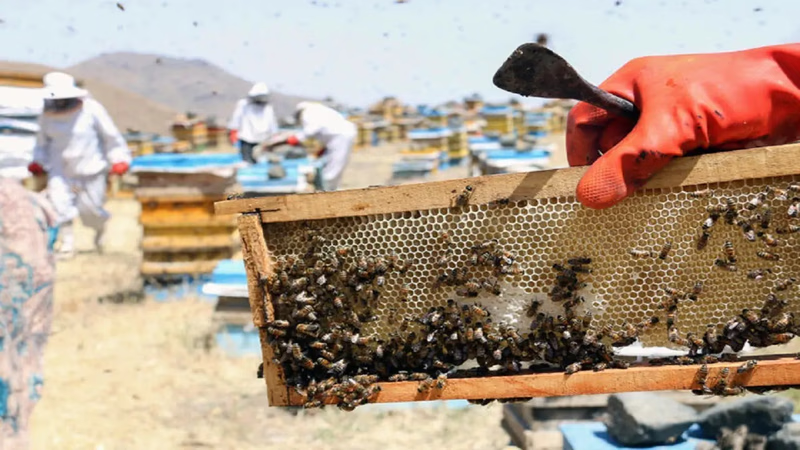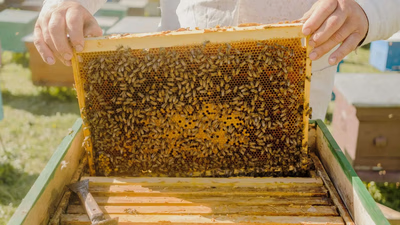
Honey production insights from Middle East trade platforms.
Countries in the Middle East and Southwest Asia, including Iran, Saudi Arabia, Turkey , and the United Arab Emirates , are significant producers of honey. Each country has differences in the production and type of honey produced. For example, Iran is known for producing saffron honey, wild flower honey and apricot honey. In many countries of the Middle East and Southwest Asia, honey has been a local product and has been used since ancient times, and its domestic consumption is also high. Honey is used in local foods and drinks as part of the consumption tradition and culture in these regions.
In Iran, honey is used as one of the local products and its consumption is very common. According to statistics, per capita consumption of honey in Iran was about one kilogram per person per year. But it should be noted that these statistics may have changed and depend on various factors. Honey consumption is also very common in Saudi Arabia. According to the culture and consumption traditions in this country, per capita consumption of honey may be between 1 and 2 kg per year for each person. Of course, these statistics may also change and depend on various factors. Türkiye is also one of the honey consuming countries in the Middle East. Per capita consumption of honey in Turkey may be about 0.5 to 1 kg per person per year. This statistic may also be variable and depends on various factors.
The largest exporters of honey in West Asia:
- Iran is known as one of the largest producers and exporters of honey in the region. Saffron honey and wild flower honey are among Iran's export products.
- Türkiye is also active in the production and export of honey to world markets. The production of honey complex is done in some mountainous regions of Türkiye.
- In Saudi Arabia, honey is widely produced and exported. Saffron honey and cinnamon honey are among the export products of Saudi Arabia.
The largest importers of honey in West Asia:
- Saudi Arabia is known as one of the largest importers of honey in the region. Due to the high demand in the domestic market, Saudi Arabia needs to import honey.
- The United Arab Emirates is also known as one of the importers of honey in the region. Due to the high demand in the domestic market and the diversity of consumers, importing honey is popular in the United Arab Emirates.
- Iraq is also known as one of the importers of honey in the region. Due to the high demand in the domestic market and the need to supply honey for various industries, Iraq is forced to import honey.
Some countries in the Middle East and Southwest Asia produce their honey for export to other countries. Some of the honey export destinations include European, Asian and Persian Gulf countries. Also, special and unusual honeys such as saffron honey and rosemary honey may also be exported as special products. In addition to edible uses, honey is also used in some other industries. For example, honey may be used in cosmetics, pharmaceuticals and food industries.
-

Honey production in South West Asia is influenced by diverse flora and climatic conditions, resulting in unique flavors and health benefits. The region"s honeys are known for their antibacterial, antioxidant, and potential anticancer properties. Key areas for honey production include the Alborz mountains in Iran, the Caucasus Mountains, and the Himalayan region. Each area offers distinct floral sources such as saffron, lily, and apricot, contributing to the honey"s unique taste and health benefits. Factors like weather conditions, plant diversity, and beekeeping practices play a crucial role in determining honey quality. Additionally, political stability and legal regulations impact beekeeping activities across these countries. The rich biodiversity of the Middle East enhances the potential for high-quality honey production that stands out globally.
-

Honey significantly contributes to the gross national product and income of Middle Eastern countries, particularly in Iran, Turkey, and Saudi Arabia. The local production of honey not only creates jobs but also adds value to the agricultural sector, enhancing the overall economy. Exporting honey generates foreign exchange and boosts gross national income, while also serving as a popular tourism product. Tourists often purchase local honey as souvenirs, further benefiting the tourism industry. Additionally, honey production supports rural economies by providing income sources and reducing migration from villages. While many Middle Eastern countries are known for their honey exports, some also import honey to meet domestic demands. This trade fosters technology exchange and strengthens regional trade relations. To effectively market honey in these regions, producers should focus on local advertising and highlight the unique qualities of their products.
Collaborating with local merchants and participating in international trade fairs can enhance export opportunities. Understanding target markets and customer preferences is crucial for successful marketing strategies. Emphasizing product quality through sustainable practices can attract more customers, while compliance with import standards is essential for accessing certain markets. Partnering with established brands can further increase market reach and consumer trust.
-

Middle Eastern and Southwest Asian countries, including Iran, Saudi Arabia, Turkey, and the UAE, are key players in honey production and consumption. Each nation has unique honey varieties; for instance, Iran is renowned for saffron and wildflower honey. The region"s rich cultural heritage incorporates honey into local cuisine, with per capita consumption varying: approximately 1 kg in Iran, 1-2 kg in Saudi Arabia, and 0. 5-1 kg in Turkey. Notably, Iran stands out as a leading exporter of honey in West Asia, while Turkey also contributes significantly to global markets. Saudi Arabia is a major importer due to high domestic demand, alongside the UAE and Iraq. The export market includes diverse destinations across Europe and Asia, with specialty honeys like saffron and rosemary gaining traction. Beyond culinary uses, honey finds applications in cosmetics and pharmaceuticals.
Understanding these dynamics offers valuable insights into the regional trade landscape. "
-

In the West Asian food market, jam and honey differ significantly in ingredients, production methods, cultural significance, and market dynamics. Jam is made from fruits, sugar, and pectin, while honey is a natural product derived from bees. Culturally, jam is used as a spread or in desserts but lacks the deep-rooted significance of honey, which is revered for its health benefits and historical importance. The market presence of jam is steady with local production using regional fruits like figs and apricots. In contrast, honey enjoys high demand due to its culinary versatility and perceived health advantages. Countries like Yemen and Saudi Arabia are known for their premium honey varieties. While both products are available in local markets, honey generally commands a higher price point due to its nutritional value and quality. Jam"s consumption varies by region but tends to be less popular than honey overall.
Factors influencing the trade of both products include cultural preferences, economic conditions, and changing consumer habits. Honey"s rich nutrient profile contributes to its popularity as a natural sweetener in cooking and baking, while jam offers diverse flavors reflecting local harvests.




